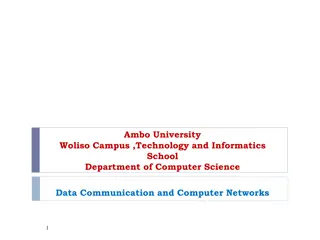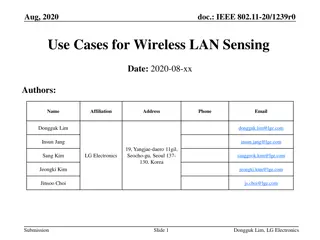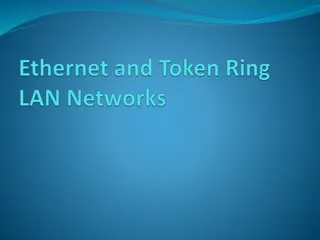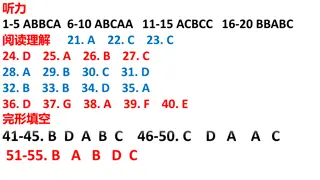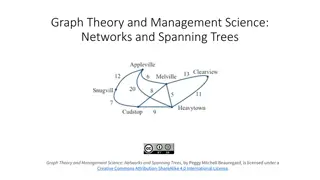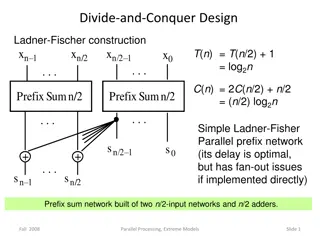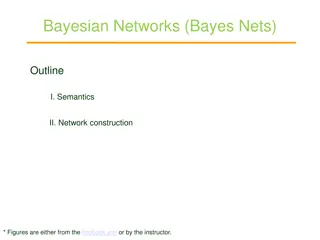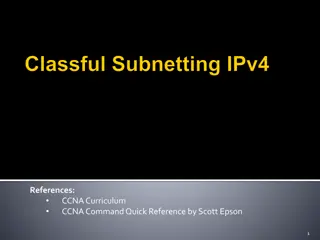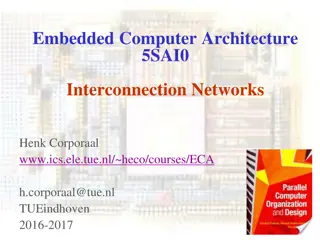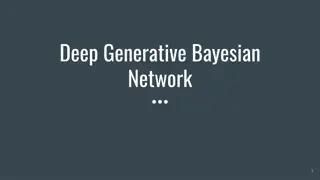Computational Physics (Lecture 18)
Neural networks explained with the example of feedforward vs. recurrent networks. Feedforward networks propagate data, while recurrent models allow loops for cascade effects. Recurrent networks are less influential but closer to the brain's function. Introduction to handwritten digit classification
0 views • 55 slides
Evolution and Potential of 5G Technology
Explore the evolving landscape of 5G technology, from enhanced mobile broadband to groundbreaking use cases and standalone networks. Learn how supportive regulations and spectrum allocation are vital for unlocking 5G's full potential. Discover the transformative impact of Standalone 5G networks on i
8 views • 10 slides
Understanding Computer Networks: Types and Characteristics
In the realm of computer networks, nodes share resources through digital telecommunications networks. These networks enable lightning-fast data exchange and boast attributes like speed, accuracy, diligence, versatility, and vast storage capabilities. Additionally, various types of networks exist tod
9 views • 12 slides
Graph Neural Networks
Graph Neural Networks (GNNs) are a versatile form of neural networks that encompass various network architectures like NNs, CNNs, and RNNs, as well as unsupervised learning models such as RBM and DBNs. They find applications in diverse fields such as object detection, machine translation, and drug d
2 views • 48 slides
Understanding Artificial Neural Networks From Scratch
Learn how to build artificial neural networks from scratch, focusing on multi-level feedforward networks like multi-level perceptrons. Discover how neural networks function, including training large networks in parallel and distributed systems, and grasp concepts such as learning non-linear function
1 views • 33 slides
Understanding Back-Propagation Algorithm in Neural Networks
Artificial Neural Networks aim to mimic brain processing. Back-propagation is a key method to train these networks, optimizing weights to minimize loss. Multi-layer networks enable learning complex patterns by creating internal representations. Historical background traces the development from early
1 views • 24 slides
Exploring Samsung SmartThings Hub and Zigbee/Zwave Networks
The Samsung SmartThings hub is a versatile device connecting Zigbee and Zwave networks, offering secure access to SkySpark via HTTPS. Zigbee and Zwave networks operate on distinct frequencies, enabling efficient communication without interference with WiFi. These networks support various devices for
0 views • 19 slides
Understanding Wireless Wide Area Networks (WWAN) and Cellular Network Principles
Wireless Wide Area Networks (WWAN) utilize cellular network technology like GSM to facilitate seamless communication for mobile users by creating cells in a geographic service area. Cellular networks are structured with backbone networks, base stations, and mobile stations, allowing for growth and c
2 views • 17 slides
Understanding Interconnection Networks in Multiprocessor Systems
Interconnection networks are essential in multiprocessor systems, linking processing elements, memory modules, and I/O units. They enable data exchange between processors and memory units, determining system performance. Fully connected interconnection networks offer high reliability but require ext
1 views • 19 slides
Understanding Computer Networks in BCA VI Semester
Computer networks are vital for sharing resources, exchanging files, and enabling electronic communications. This content explores the basics of computer networks, the components involved, advantages like file sharing and resource sharing, and different network computing models such as centralized a
1 views • 96 slides
Understanding Computer Communication Networks at Anjuman College
This course focuses on computer communication networks at Anjuman College of Engineering and Technology in Tirupati, covering topics such as basic concepts, network layers, IP addressing, hardware aspects, LAN standards, security, and administration. Students will learn about theoretical and practic
0 views • 72 slides
Introduction to Neural Networks in IBM SPSS Modeler 14.2
This presentation provides an introduction to neural networks in IBM SPSS Modeler 14.2. It covers the concepts of directed data mining using neural networks, the structure of neural networks, terms associated with neural networks, and the process of inputs and outputs in neural network models. The d
0 views • 18 slides
Introduction to Computer Networks at Ambo University Woliso Campus
Learn about computer networks at Ambo University's Woliso Campus, covering topics such as network applications, types of computer networks (LAN, MAN, WAN), and the advantages of networking. Explore the basics of data communication, resource sharing, and network architectures.
0 views • 30 slides
Enhancing Agriculture Through Global Knowledge Networks and Information Management Systems
Global and regional knowledge networks play a vital role in agriculture by facilitating information sharing, collaboration, capacity building, and coordination among stakeholders. These networks improve access to information, foster collaboration, enhance capacity building, and strengthen coordinati
0 views • 5 slides
Wireless LAN Sensing Use Cases in Home Environments
The document discusses use cases for Wireless LAN (WLAN) sensing in home environments, focusing on the connection between multiple access points and home appliances for enhanced performance. It outlines scenarios such as gesture-controlled home appliance operation, user identification for personaliz
0 views • 11 slides
Understanding Router Routing Tables in Computer Networks
Router routing tables are crucial for directing packets to their destination networks. These tables contain information on directly connected and remote networks, as well as default routes. Routers use this information to determine the best path for packet forwarding based on network/next hop associ
0 views • 48 slides
Understanding WAN Technologies and Routing in Large Networks
WAN technologies enable communication over large geographic distances, connecting multiple sites efficiently. Packet switches play a crucial role in forwarding packets, with modern WAN architecture focusing on interconnecting switches using LAN technology and leased digital circuits. Store and forwa
1 views • 17 slides
P-Rank: A Comprehensive Structural Similarity Measure over Information Networks
Analyzing the concept of structural similarity within Information Networks (INs), the study introduces P-Rank as a more advanced alternative to SimRank. By addressing the limitations of SimRank and offering a more efficient computational approach, P-Rank aims to provide a comprehensive measure of si
0 views • 17 slides
Understanding Local Area Networks (LAN) and IEEE Project 802
A Local Area Network (LAN) is a computer network designed for limited geographic areas, often interconnected with wide area networks (WANs) or the Internet. IEEE Project 802 established standards for LAN protocols, focusing on the physical and data link layers. Ethernet emerged as the dominant LAN t
0 views • 27 slides
Comprehensive Overview of Computer Networks and Protocols for GCSE Level
Explore the diverse aspects of computer networks and protocols through in-depth discussions on LAN, WAN, client-server relationships, hardware requirements, network topologies, protocols like TCP/IP and HTTP, and the significance of network layers. Understand the roles, benefits, and risks associate
0 views • 23 slides
Understanding Advanced Classifiers and Neural Networks
This content explores the concept of advanced classifiers like Neural Networks which compose complex relationships through combining perceptrons. It delves into the workings of the classic perceptron and how modern neural networks use more complex decision functions. The visuals provided offer a cle
0 views • 26 slides
Cultural Experience in San Francisco Journal
Li Lan describes her cultural adventure in San Francisco, exploring the diverse neighborhoods, enjoying multicultural cuisine, and learning about the city's history. From street art in the Mission District to a museum showcasing California's past, she immerses herself in the blend of cultures. In Ch
0 views • 15 slides
Understanding Relational Bayesian Networks in Statistical Inference
Relational Bayesian networks play a crucial role in predicting ground facts and frequencies in complex relational data. Through first-order and ground probabilities, these networks provide insights into individual cases and categories. Learning Bayesian networks for such data involves exploring diff
0 views • 46 slides
Understanding Overlay Networks and Distributed Hash Tables
Overlay networks are logical networks built on top of lower-layer networks, allowing for efficient data lookup and reliable communication. They come in unstructured and structured forms, with examples like Gnutella and BitTorrent. Distributed Hash Tables (DHTs) are used in real-world applications li
0 views • 45 slides
Understanding Networks: An Introduction to the World of Connections
Networks define the structure of interactions between agents, portraying relationships as ties or links. Various examples such as the 9/11 terrorists network, international trade network, biological networks, and historical marriage alliances in Florence illustrate the power dynamics within differen
0 views • 46 slides
Understanding Graph Theory and Networks: Concepts and Applications
Explore the concepts of graph theory and management science, focusing on networks, spanning trees, and their practical applications. Learn about the difference between a snowplow tracing streets, a traveler visiting cities, and connecting towns with cables. Discover how networks like Facebook evolve
0 views • 15 slides
Parallel Prefix Networks in Divide-and-Conquer Algorithms
Explore the construction and comparisons of various parallel prefix networks in divide-and-conquer algorithms, such as Ladner-Fischer, Brent-Kung, and Kogge-Stone. These networks optimize computation efficiency through parallel processing, showcasing different levels of latency, cell complexity, and
1 views • 21 slides
Understanding Wireless Networks: Types and Applications
Wireless networks utilize wireless data connections to connect network nodes and share resources. They include Wireless Personal Area Networks (WPAN), Wireless LAN, Wireless WAN, Wireless Broadband, and Wireless Cellular. Each type has specific characteristics and applications, such as linking perso
0 views • 29 slides
Diverse Social Entities Mining from Linked Data in Social Networks
This research focuses on mining diverse social entities from linked data in social networks using a DF-tree structure and DF-growth mining algorithm. The study explores the extraction of important linked data in social networks and the mining of various social entities such as friends. Prominence va
0 views • 13 slides
Overview of External Wireless Communication System on International Space Station (ISS)
This presentation covers the overview and experience of implementing an external 802.11n wireless communication system on the International Space Station (ISS). It discusses the existing wireless system, committed users, system architecture, and future challenges. The system provides high data rate
0 views • 18 slides
Understanding Local Area Networks: Basics, Advantages, and Disadvantages
A Local Area Network (LAN) serves various functions such as file serving, print serving, video transfers, and more. LANs offer advantages like resource sharing, private ownership, and secure transfers, but come with disadvantages such as costliness and maintenance issues. Different LAN topologies li
1 views • 50 slides
Understanding Bayesian Networks: A Comprehensive Overview
Bayesian networks, also known as Bayes nets, provide a powerful tool for modeling uncertainty in complex domains by representing conditional independence relationships among variables. This outline covers the semantics, construction, and application of Bayesian networks, illustrating how they offer
0 views • 17 slides
Understanding LAN Technologies and Subnetting in Networking
Subnetting involves dividing larger networks into smaller subnets by borrowing bits from HOST bits. This process does not increase the number of hosts but instead decreases hosts by losing two host IP addresses for each subnet. Different LAN technologies like Ethernet and Token Ring are used in netw
0 views • 23 slides
Understanding Network Analysis: Whole Networks vs. Ego Networks
Explore the differences between Whole Networks and Ego Networks in social network analysis. Whole Networks provide comprehensive information about all nodes and links, enabling the computation of network-level statistics. On the other hand, Ego Networks focus on a sample of nodes, limiting the abili
0 views • 31 slides
Evolution of Networking: Embracing Software-Defined Networks
Embrace the future of networking by transitioning to Software-Defined Networks (SDN), overcoming drawbacks of current paradigms. Explore SDN's motivation, OpenFlow API, challenges, and use-cases. Compare the complexities of today's distributed, error-prone networks with the simplicity and efficiency
0 views • 36 slides
Understanding Computer Networking Basics and Distributed Systems
Computer networks facilitate the sharing of devices and resources like servers, clients, and data, while distributed systems involve components located on different networked computers communicating to achieve common goals. Types of computer networks include LAN, PAN, MAN, and WAN. Distributed syste
0 views • 17 slides
Understanding Interconnection Networks in Embedded Computer Architecture
Explore the intricacies of interconnection networks in embedded computer architecture, covering topics such as connecting multiple processors, topologies, routing, deadlock, switching, and performance considerations. Learn about parallel computer systems, cache interconnections, network-on-chip, sha
0 views • 43 slides
Enhancing Wireless LAN Throughput with Multiple Primary Channels
This document discusses the need for increasing system throughput in wireless LAN networks due to the growing demand for WLAN traffic. By introducing multiple primary channels, unused resources scattered across various channels can be exploited to improve quality of service and enhance transmission
0 views • 20 slides
LAN Hardware Components and Connectivity Mediums
LAN hardware components, such as cables, repeaters, hubs, switches, and network interface cards, play a crucial role in transmitting electric signals between devices. Cables are the primary connectivity medium, with factors like bandwidth and distance affecting data transmission. External disturbanc
0 views • 26 slides
Understanding Deep Generative Bayesian Networks in Machine Learning
Exploring the differences between Neural Networks and Bayesian Neural Networks, the advantages of the latter including robustness and adaptation capabilities, the Bayesian theory behind these networks, and insights into the comparison with regular neural network theory. Dive into the complexities, u
0 views • 22 slides












